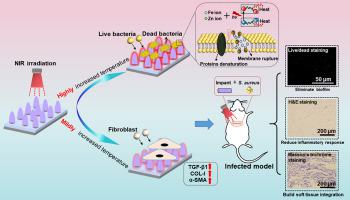Bioactive Materials ( IF 18.9 ) Pub Date : 2021-06-29 , DOI: 10.1016/j.bioactmat.2021.06.029 Yang Xue 1 , Jun Chen 2, 3 , Tiexin Ding 1 , Mengting Mao 1 , Shengbo Zhu 1 , Jianhong Zhou 4 , Lan Zhang 1 , Yong Han 1

|
Killing bacteria, eliminating biofilm and building soft tissue integration are very important for percutaneous implants which service in a complicated environment. In order to endow Ti implants with above abilities, multifunctional coatings consisted of Fe2O3–FeOOH nanograins as an outer layer and Zn doped microporous TiO2 as an inner layer were fabricated by micro-arc oxidation, hydrothermal treatment and annealing treatment. The microstructures, physicochemical properties and photothermal response of the coatings were observed; their antibacterial efficiencies and cell response in vitro as well as biofilm elimination and soft tissue integration in vivo were evaluated. The results show that with the increased annealing temperature, coating morphologies didn't change obviously, but lattices of β-FeOOH gradually disorganized into amorphous state and rearranged to form Fe2O3. The coating annealed at 450 °C (MA450) had nanocrystallized Fe2O3 and β-FeOOH. With a proper NIR irradiation strategy, MA450 killed adhered bacteria efficiently and increased fibroblast behaviors via up-regulating fibrogenic-related genes in vitro; in an infected model, MA450 eliminated biofilm, reduced inflammatory response and improved biointegration with soft tissue. The good performance of MA450 was due to a synergic effect of photothermal response and released ions (Zn2+ and Fe3+).
中文翻译:

通过在感染模型中调节 NIR 辐射来构建 Fe2O3-FeOOH 涂层钛植入物的生物整合
对于在复杂环境中使用的经皮植入物而言,杀灭细菌、消除生物膜和构建软组织整合非常重要。为了赋予Ti植入物上述能力,通过微弧氧化、水热处理和退火处理制备了由Fe 2 O 3 -FeOOH纳米颗粒作为外层和Zn掺杂微孔TiO 2作为内层的多功能涂层。观察涂层的微观结构、理化性能和光热响应;它们的体外抗菌效率和细胞反应以及体内生物膜消除和软组织整合被评估。结果表明,随着退火温度的升高,涂层形貌没有明显变化,但β-FeOOH的晶格逐渐解体为非晶态并重新排列形成Fe 2 O 3。450 ℃退火的涂层(MA450)纳米晶化Fe 2 O 3和β-FeOOH。通过适当的近红外辐射策略,MA450在体外通过上调成纤维相关基因,有效杀死粘附细菌并增加成纤维细胞行为;在感染模型中,MA450 消除了生物膜,减少了炎症反应并改善了与软组织的生物整合。MA450 的良好性能是由于光热响应和释放的离子(Zn2+和 Fe 3+ )。


























 京公网安备 11010802027423号
京公网安备 11010802027423号